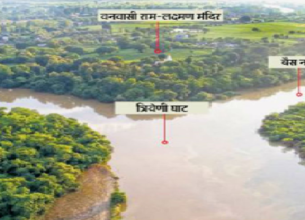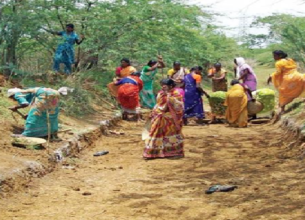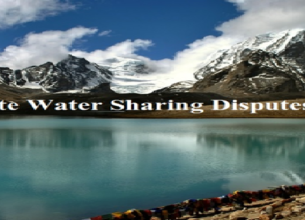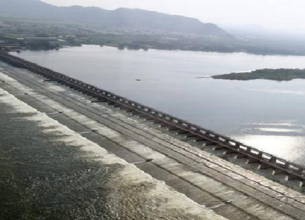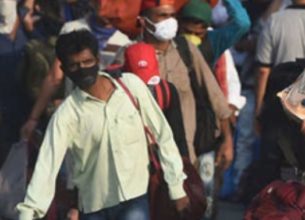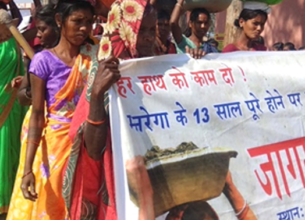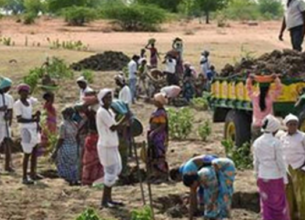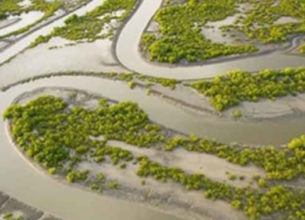NOT MANY LESSONS LEARNT FROM WATER PLANNING FAILURES
13, Dec 2019

Prelims level : Governance - Schemes
Mains level : GS-II Government policies and interventions for development in various sectors and Issues Arising out of their Design and Implementation.
Context:
- In the absence of scientific planning and implementation, measures like Jal Shakti Abhiyan may not be successful, says Water Experts.
Today’s Water Scenario:
- Following the massive water crisis across India in the summer of 2019, the Central government hurriedly launched the Jal Shakti Abhiyan (JSA), a time-bound, mission-mode water conservation campaign to be carried out in two phases, across the 255 districts having critical and over-exploited groundwater levels.
- This campaign, however, was not intended to be a funding programme and did not create any new intervention on its own.
- It only aimed to make water conservation a ‘people’s movement’ through ongoing schemes like the MGNREGA and other government programmes.
About Jal Shakti Abhiyan:
- It is a time-bound, mission-mode campaign that would focus on 1,592 “water-stressed” blocks in 257 districts.
- The campaign will run through citizen participation during the monsoon season, from 1st July, 2019 to 15th September, 2019.
- The 1,592 blocks, identified as “water-stressed” as per the Central Ground Water Board’s 2017 data, include 313 critical blocks, 1,000-odd over-exploited blocks and 94 blocks with least water availability (for states without water-stressed blocks).
- Jal Shakti Abhiyan is a collaborative effort of various Ministries of the Government of India and State Governments, being coordinated by the Department of Drinking Water and Sanitation.
- Under the campaign, teams of officers from the central government will visit and work with district administration in water stressed blocks, to ensure five important water conservation interventions.
- These will be water conservation and rainwater harvesting, renovation of traditional and other water bodies/tanks, reuse, bore well recharge structures, watershed development and intensive afforestation.
- These water conservation efforts will also be supplemented with special interventions including the development of Block and District Water Conservation Plans, promotion of efficient water use for irrigation and better choice of crops through Krishi Vigyan Kendras.
- A large-scale communications campaign has also been planned alongside the JSA involving mass mobilization of different groups including school students, college students, swachhagrahis, Self Help Groups, Panchayati Raj Institution members, youth groups (NSS/NYKS/NCC), defence personnel, ex-servicemen and pensioners, among various others.
Need for Scientific Planning for Water Conservation:
- Water planning should be based on hydrological units, namely river basins. And, political and administrative boundaries of districts rarely coincide with the hydrological boundaries or aquifer boundaries.
- However, contrary to this principle of water management, JSA was planned based on the boundary of the districts, and to be carried out under the overall supervision of a bureaucrat.
- This resulted in the division of basins/aquifers into multiple units that followed multiple policies. There was no data on basin-wise rainfall, no analysis of run-off and groundwater maps were rarely used.
- As a result, one never came to know whether water harvested in a pond in a district was at the cost of water in adjoining districts.
- The JSA also fundamentally ignored the fact that most of India’s water-stressed basins, particularly those in the peninsular regions, are facing closure, with the demand exceeding supply.
- Hence, groundwater recharge happened at the cost of surface water and vice versa. This is where an absence of autonomous and knowledge-intensive river-basin organisations is acutely felt.
Data’s given by JSA:
- The JSA’s portal displays impressive data, images and statistics.
- For example, it claims that there are around 10 million ongoing and completed water conservation structures; 7.6 million recharge structures.
- The website also says that one billion saplings have been planted and that six million people participated in awareness campaigns.
Contradictions with JSA’s Data:
- The data displayed on JSA portal do not speak anything about the pre-JSA water levels, the monthly water levels and impact of monsoon on the water levels across the 255 districts with critical and over-exploited blocks.
- They also don’t convey anything about the quality of the structures, their maintenance and sustainability.
- Even if the water levels had been measured, it is unknown whether the measurement was accurate.
- The results for a 2016 study conducted by the Central Groundwater Board showed that water levels always increase post-monsoon.
- Therefore, it will require long-term monitoring of water level data to determine the actual impact of a measure like JSA.
- At present, there is no such parameter to measure the outcome of such a mission-mode campaign.
Drawbacks of JSA:
- Assumption by the JSA is that common people in rural areas are ignorant and prone to wasting water; on the contrary, they are the ones who first bear the burden of any water crisis.
- The per capita water allocation to those living in rural areas is 55 litres, whereas the same for urban areas like Delhi and Bengaluru is 135-150 litres.
- Therefore, the JSA’s move to reach out to poor people and farmers, asking them to ‘save water’, appears hypocritical, particularly when district administrations blatantly allow the sewage generated from towns and cities to pollute village water sources such as tanks, ponds and wells.
- Moreover, it is difficult to say whether measures like JSA can provide long-term solutions.
- Most of the farm bunds built with soil can collapse within one monsoon season due to rains and/or trespassing by farm vehicles, animals and humans.
- Further, there are issues like lack of proper engineering supervision of these structures, involvement of multiple departments with less or no coordination, and limited funding under MGNERGA and other schemes.
- Finally, there have hardly been many efforts undertaken to dissuade farmers from growing water-intensive crops such as paddy, sugarcane, and banana, when it is widely known that agriculture consumes 80% of freshwater.



